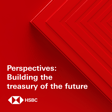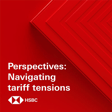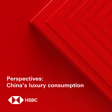Become a Creator today!Start creating today - Share your story with the world!
Start for free
00:00:00
00:00:01

The Macro Viewpoint - China’s ‘little giants’, remote working and cities, UK consumers
In this edition we look at why China is boosting support for smaller tech companies, consider what the next phase of the pandemic means for cities and discuss the results of our latest survey of UK consumers. Disclaimer. To stay connected and to access free to view reports and videos from HSBC Global Research click here.
Hosted on Acast. See acast.com/privacy for more information.
Transcript
Introduction to Global Banking Trends
00:00:00
Speaker
This is HSBC Global Viewpoint, your window into the thinking, trends and issues shaping global banking and markets.
00:00:09
Speaker
Join us as we hear from industry leaders and HSBC experts on the latest insights and opportunities for your business.
00:00:17
Speaker
Thank you for listening.
China's Support for Tech SMEs and Pandemic Impact
00:00:22
Speaker
You're listening to the HSBC Global Research Macro Viewpoint, where we speak to the economists and strategists behind some of our key reports published over the past week.
00:00:32
Speaker
Coming up this week, we look at how China is boosting support for smaller technology companies.
00:00:36
Speaker
As offices remain half full across the developed world, we look at what the next phase of the pandemic means for cities.
00:00:44
Speaker
And what's on the mind of UK consumers.
00:00:46
Speaker
We assess the key takeaways from our latest proprietary survey of 2,000 people.
00:00:51
Speaker
This podcast was reported on Thursday the 31st of March 2022.
00:00:54
Speaker
Our full disclosures and disclaimers can be found in the link attached to this podcast.
What is the 'Little Giants' Program?
00:01:00
Speaker
Hello, I'm Mary Watkins.
00:01:02
Speaker
And I'm Piers Butler.
00:01:04
Speaker
Small and medium-sized enterprises are critical to China's economy, accounting for over 60% of GDP.
00:01:10
Speaker
And Beijing is stepping up its policy support to develop SMEs in the tech sector, so-called little giants.
00:01:17
Speaker
Chu Hongbin, chief China economist, joins us from Hong Kong.
00:01:21
Speaker
Hongbin, welcome to the podcast.
00:01:23
Speaker
Thank you.
00:01:24
Speaker
So China is heavily investing in its tech sector, but it's not only the big national champions that are driving this, is it?
00:01:30
Speaker
You are absolutely right.
00:01:32
Speaker
Despite all those headline stories in the international media about how China's national champion is making significant progress in terms of technology upgrading in recent years, Beijing has actually consistently tried to make more efforts to nurture the dynamic and innovative small and medium-sized enterprises.
00:01:58
Speaker
For instance, back a few years ago, Beijing introduced a new program called Little Giants.
00:02:05
Speaker
The whole purpose of this program is to try to nurture a few of the innovative SMEs basically to upgrade their technology.
00:02:14
Speaker
Currently, there are around 5,000 national level Little Giants, and the goal is to expand this to 10,000 by 2025.
00:02:26
Speaker
10,000 companies still sounds like a fairly small number in terms of China's overall technology output.
00:02:31
Speaker
What is it that makes these little giants so significant?
00:02:34
Speaker
Yes, given the massive amount of SMEs in China, it is very difficult for the government to encourage all the SMEs to move forward in terms of technology upgrading at the same pace.
00:02:47
Speaker
Therefore, they need to be focused.
00:02:49
Speaker
They need to basically set up as a role model to show another SMEs how to effectively upgrade their technologies.
00:02:58
Speaker
And we all know that SMEs is accounting for over 60% of GDP.
00:03:03
Speaker
More importantly, also create more than 80% of urban jobs.
00:03:07
Speaker
So therefore, promoting the technology upgrading in SMEs is quite crucial for China's development
Criteria and Support for Little Giants
00:03:15
Speaker
in the future.
00:03:15
Speaker
And what criteria does an SME need to qualify as a little giant?
00:03:19
Speaker
Actually, we found out there's a quite high bar for any SMEs to be qualified as the national level little giants.
00:03:29
Speaker
They need to, for instance, have a significant market share in the particular technology sectors.
00:03:38
Speaker
They also need to have a high R&D spending.
00:03:43
Speaker
7% of the revenue, which is quite high compared with the average of less than 2-3%.
00:03:49
Speaker
And more importantly, they also look at the management capabilities as well as the potential for those companies to develop into champion companies in specific technology areas.
00:04:02
Speaker
So what sort of policy support is being put in place to nurture these little giants?
00:04:07
Speaker
Yeah, there is a basket of policy initiatives to facilitate the growth in the little giants and another more dynamic SMEs.
00:04:16
Speaker
For instance, the tax incentives as well as government research grants to support them.
00:04:22
Speaker
At the same time, they also try to encourage the financial institutions to give more credit support to those better quality SMEs.
00:04:32
Speaker
And also, at the same time, the governments also try to help those smaller companies to work together with the industrial leaders, the big companies to do or join the research.
00:04:45
Speaker
And also they try to bring some of these SMEs into the key technology project, which is sponsored by the government.
00:04:52
Speaker
So international is pretty comprehensive package of measures to support the development in those companies.
00:05:01
Speaker
Hongbin, thank you very much.
00:05:02
Speaker
Thank you.
Office Return Rates and Remote Work Preferences
00:05:05
Speaker
Pandemic-related restrictions have been removed in much of the developed world over the past few months.
00:05:10
Speaker
James Pomeroy, global economist, has been looking at what this means for workers returning to the office and cities more broadly.
00:05:17
Speaker
So James, what are the data showing us about workers returning to offices?
00:05:21
Speaker
So there's a lot of different data we can look at to try and get a sense of how many people are going back into offices.
00:05:26
Speaker
The best data we think is from Castle Systems for the US and they're tracking the number of people going to offices based on the number of past scans into those buildings.
00:05:36
Speaker
And their numbers are suggesting that we've hit about 40% office attendance in the US.
00:05:41
Speaker
And it seems sensible to think that's a
00:05:43
Speaker
relatively similar number in other parts of the developed world based on a mix of Google mobility data and public transport data too.
00:05:51
Speaker
But what's interesting is that those numbers appear to be topping out a little bit.
00:05:55
Speaker
We're back at the levels we saw in November before the Omicron wave.
00:06:00
Speaker
And there's a little bit of evidence in some of the public transport usage data that those numbers aren't quite getting back to where they were previously on that uptrend.
00:06:09
Speaker
So we could be peaking out in terms of the number of people back in offices.
00:06:14
Speaker
What would it take to get these numbers higher?
00:06:16
Speaker
So what you'd need is people to change their attitude towards going back into the office.
00:06:20
Speaker
What we're seeing at the moment is workers who are very happy and comfortable working either on a hybrid model or working much more remotely.
00:06:28
Speaker
And we have seen workplace attendance and aggregate pick up much more.
00:06:32
Speaker
So this is people going back to jobs that
00:06:34
Speaker
can't be done remotely.
00:06:35
Speaker
But what we are seeing is a lot of workers who are very comfortable working remotely or happy working in a hybrid system.
00:06:42
Speaker
And you need that attitude towards that change.
00:06:45
Speaker
That's not necessarily something we think is likely because at the moment, what you've got is businesses saying they want to get people back in the office three or four days a week.
00:06:55
Speaker
And you've got workers saying they want to be back in the office one, two or three days a week.
00:07:00
Speaker
And there's a discrepancy there that means actually
00:07:03
Speaker
Whilst these numbers could keep grinding higher as more and more sort of comfort builds as we come out of the stage of the pandemic, what we could also see is that businesses have to change their expectations and not almost push people back into the office as much.
00:07:19
Speaker
And that could mean that this sort of 40 percent attendance could be closer to a peak than we might think.
00:07:24
Speaker
In terms of the impact on the economy, what does this mean for the world of work?
00:07:28
Speaker
So it's quite interesting in terms of the way businesses we think are going to have to adapt.
00:07:32
Speaker
We think we're going to have to see businesses think about in a very tight labour market what they can do to attract workers and workers value flexibility.
00:07:42
Speaker
They want to work in a flexible situation.
00:07:45
Speaker
There's a survey evidence that suggests that across most of the world, the ability to work flexibly is equivalent to about a 5% pay increase.
00:07:54
Speaker
And about 15 to 20 percent of workers say they would leave their job if they were told that they had to be back in the office five days a week.
00:08:01
Speaker
So this is an interesting dynamic where these tools, I guess, that businesses can use can be used in a way to either attract workers or retain workers.
00:08:10
Speaker
And that's why we think we could see a greater spread of remote working in the coming years, even from where we are today.
How is Remote Work Affecting the Housing Market?
00:08:18
Speaker
So with people working from home more, what impact is this having on the housing market?
00:08:22
Speaker
So there's some really interesting data in the US where we get fantastic data from Zillow broken down by zip code.
00:08:29
Speaker
And if we take those individual zip code data and we look at the difference in densities in different parts of the country, we can see that almost all of the increase in house prices and rental prices has come from suburbs and exurbs.
00:08:42
Speaker
So basically suburban areas
00:08:45
Speaker
and rural areas.
00:08:47
Speaker
And that's really interesting because this continued spread of remote working or continued trend of remote working is likely to keep prices in those areas relatively elevated.
00:08:57
Speaker
The question is how much further can they go?
00:09:00
Speaker
And that will have a big determinant in the overall pace of house price growth, but also in terms of rental inflation, two very important metrics when central banks are setting policy.
00:09:10
Speaker
So we could continue to see this push for property in these parts of countries.
00:09:15
Speaker
And what that could do is push rental inflation even higher.
00:09:18
Speaker
It could push house prices even higher.
00:09:20
Speaker
And that's a world where central banks may feel a little bit more comfortable with higher interest rates.
00:09:25
Speaker
James, thanks for your time.
00:09:27
Speaker
Thanks very much.
UK Consumer Insights and Spending Trends
00:09:31
Speaker
Sticking with the theme of the post-pandemic world, let's find out what's on the mind of UK consumers.
00:09:36
Speaker
In our latest proprietary survey, 2,000 people were asked 80 questions about the economy, food retail, clothing, and travel and leisure.
00:09:45
Speaker
Andrew Porteous, Co-Head of European Consumer Retail Research, is here to talk us through the findings.
00:09:50
Speaker
Andrew, welcome to the podcast.
00:09:52
Speaker
Thank you for having me on.
00:09:53
Speaker
So, Andrew, in terms of the overall economy, what were some of the key takeaways from the survey?
00:09:58
Speaker
So when we ask consumers about the economy, I think that the most notable takeaway here really is that consumers are really concerned about the cost of living.
00:10:06
Speaker
When we ask consumers what they were concerned about, 69% cited rising living costs as their primary concern.
00:10:13
Speaker
And that's the highest it's ever been in the surveys that we've conducted in this area.
00:10:17
Speaker
Also, there's a perception out there that savings will support spending this year, and that's reassured a lot of people.
00:10:24
Speaker
But the responses to our survey suggest that that might not be the case.
00:10:27
Speaker
When we asked consumers did they save money over the course of the pandemic, a lot said they did.
00:10:33
Speaker
Only 34% of consumers said no, but only 14% of consumers said yes, but they plan to spend those savings this year.
00:10:42
Speaker
16% of consumers said they'd already spent the savings and 36% said they plan to save it.
00:10:48
Speaker
So it seems that savings might not be the big support to consumer spending that it might otherwise have been.
00:10:54
Speaker
You've looked at obviously all the consumer subsectors.
00:10:58
Speaker
What were the things that stood out from, say, food retailing, travel and ledger, food manufacturing?
00:11:03
Speaker
Yeah, absolutely.
00:11:04
Speaker
I mean, starting with the food retail side of things, and I think echoing that economic picture around inflation, we saw a notable deterioration in price perception.
00:11:14
Speaker
We asked customers across a broad range of areas about how the supermarkets were stacking up and price perception was one that dropped back probably as prices are going up across supermarkets.
00:11:26
Speaker
On the non-food side of things, it was much more about the normalization picture.
00:11:30
Speaker
And here we saw, for example, in consumers' top choices for where they buy clothing, that it was really the store-based operators that bounced back.
00:11:40
Speaker
So strong performances from the likes of Next and Primark, but a much weaker performance from the likes of ASOS and Boohoo, reversing some of those pandemic gains they've seen.
00:11:50
Speaker
Then on the travel and leisure space, it was really about the return to work and willingness to travel.
00:11:55
Speaker
So the number of respondents that were looking to travel this year more than doubled from last year's level and people looking for things to return back to normal there.
00:12:06
Speaker
So they were the main trends.
00:12:08
Speaker
I'd say overall across the survey, the two big themes that we would pick out is that concern over inflation, but also that normalisation as we emerge from a pandemic.
00:12:17
Speaker
Yes, everybody seems to want to book a flight and go on a holiday.
00:12:21
Speaker
Absolutely.
00:12:21
Speaker
Absolutely.
00:12:22
Speaker
So this is the sixth edition of this proprietary survey, which kicked off back in 2017.
00:12:30
Speaker
Have you observed over that period of time any changes in consumer behavior, any trends that you'd like to highlight?
00:12:37
Speaker
Yeah, absolutely.
00:12:38
Speaker
I think there are some trends and there are also some things that are consistent.
00:12:43
Speaker
I think taking the retail space, that trend towards in food, the growth of the discounters, which has been a big theme, is very clear from the surveys that we do.
00:12:56
Speaker
They've risen in prominence and are taking a bigger share of customers' baskets.
00:13:00
Speaker
In the non-food side, it's much more about the online piece.
00:13:04
Speaker
Those retailers have done very, very well over a longer period of time, as you've seen structural growth in that channel.
00:13:10
Speaker
At the same time, as I said, those consistencies.
00:13:12
Speaker
So in food retail, I point to the fact that what matters to consumers doesn't often change that much.
00:13:18
Speaker
So it's about location.
00:13:20
Speaker
It's about price and value for money.
00:13:22
Speaker
That's what really drives choice.
00:13:24
Speaker
I think on the leisure side, really, it's about the importance of those experiences, you know, the importance of holidays to people, of getting away.
00:13:33
Speaker
These are the areas that people like to spend their incremental pounds on.
00:13:38
Speaker
Eating out is also something that features prominently.
00:13:41
Speaker
And we see that in the data as well, with over a long period of time, growth in services and leisure outpacing the demand for hard goods.
00:13:49
Speaker
Andrew, thank you very much.
00:13:51
Speaker
My pleasure.
00:13:51
Speaker
Thank you for having me again.
00:13:55
Speaker
So that's all from us today.
00:13:56
Speaker
Thank you to our guests, Chu Hongbin, James Pomeroy and Andrew Porteus.
00:14:00
Speaker
Thanks very much for listening.
00:14:01
Speaker
We'll be back again next week.
00:14:10
Speaker
Thank you for listening today.
00:14:12
Speaker
This has been HSBC Global Viewpoint, Banking and Markets.
00:14:16
Speaker
For more information about anything you heard in this podcast or to learn about HSBC's global services and offerings, please visit gbm.hsbc.com.

















